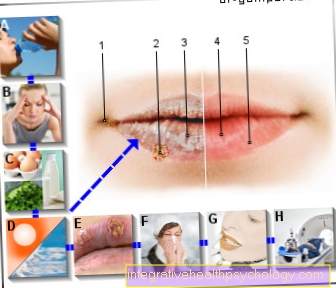Gum transplant
Definition
In gum transplantation, gums are removed from a specific location and then implanted in another location. These grafts, mostly obtained from the palate, are used to cover recessions, i.e. exposed tooth necks, or non-healing wounds on the jawbone. The tissue is sewn to the appropriate place with threads and heals there within a few weeks. Due to a wide variety of adaptation processes, the tissue can then hardly be distinguished from the surrounding gums, and excellent aesthetics are created, especially in the anterior region.
Also read the article on the topic: Tooth neck is exposed - what to do?

When does a gum transplant make sense?
A gum transplant can be useful in many situations in order to improve the aesthetics, especially to restore in the anterior region. The main cause is the exposed tooth necks, which, in addition to an unsightly appearance, sometimes also trigger symptoms such as sensitivity to cold in the affected tooth. In addition to congenital receding gums, the wrong brushing technique, too fast tooth movement by the orthodontist, long-lasting gum inflammation or poorly fitting dentures can also be the cause.
The danger is often underestimated, especially when cleaning. If you use a toothbrush that is too hard or too worn and brush with great force at the wrong angle or with the wrong technique, you can quickly destroy the fine fibers of the gums. In people with a very "thin gum type", so-called recessions then quickly develop. This is a non-inflammatory tissue remodeling that is not caused by dental plaque.
It is a different matter if the recessions are caused by periodontal therapy. Inflammatory concretions have already caused bone loss around the teeth. If the cleaned gum pockets now heal, the gums retract due to the previous inflammation and adapt to the bone.
You might also be interested in this topic:
- How can you rebuild gums?
- Receding gums
Concomitant symptoms
If the gum transplant is necessary, the problem of very sensitive tooth necks or an unsightly aesthetic of the gum transition in the front teeth is often present. The pain always arises when cold air or cold water reaches the teeth. The gum transplant may result in slight bleeding after the procedure until it has healed. Especially at the removal site, as the wound has to heal openly, similar to a large and deep abrasion. However, as it is constantly exposed to saliva, liquids and food in the mouth, it is a long and sometimes quite painful process.
After healing, this area on the palate can still be sensitive for a long time. Warm and spicy produce a painful stimulus. Sometimes the area is numb for a longer period of up to half a year before the feeling slowly comes back. The same applies to the recipient site, but since the wound is smaller and tightly sutured, these side effects tend to occur there rarely.
You might also be interested in this topic: Pain in the neck of the tooth - that's behind it!
The process of a gum transplant
The gum transplant is carried out by a dentist with special training. After a previous diagnosis, the planned procedure will be carried out in another appointment. For this purpose, a syringe is given in two places in order to anesthetize both the removal and recipient sites. As soon as this takes effect, the recipient site will be prepared. There are various techniques for doing this. In the simplest case, the edges of this point are "freshened", which means that a small layer is removed from the edge with a scalpel so that it starts to bleed. This bleeding is necessary because the transplant itself has no blood vessels and must be supplied and nourished by the recipient site and its blood supply. This is the only way to guarantee problem-free growth.
Then the size of the required graft is marked at the removal site, often on the palate, and then cut out. It is adapted to the recipient site and then tightly fixed with several sutures. The extraction point must heal open. For better wound healing, a "bandage plate" can be made for the palate. This is a plate that fits tightly to the palate and the upper jaw teeth and is inserted after the procedure. This has a similar effect to a pressure bandage and so stills the resulting wound, as it is inserted immediately after removal. It must be worn for a whole day without a break at the beginning. This microsurgical intervention is one of the most uncomplicated standard interventions by a specialized dentist.
What are the risks?
As with any surgical procedure, there are also risks with gum transplantation. Nerves can be hit during anesthesia, which leads to a loss of sensation in the corresponding area. The lower jaw is particularly affected here when what is known as "conduction anesthesia" is performed. There is a risk of hitting a larger blood vessel on the palate, which can lead to profuse (re) bleeding. The increased blood loss sometimes upsets the circulation a little. Quite common side effects, which, however, usually heal again without problems, are swelling and wound pain. These subside after a few days.
How long does it take to heal?
The healing is slightly different at the two transplant sites. At the “donor site” on the palate, healing is somewhat prolonged, as the tissue there has to completely renew itself and an open wound has to heal. It often takes several weeks to fully regenerate and eat normally.
The healing time is shorter at the “receiving point”, i.e. where the open neck of the tooth is covered. The tissue is sewn on and after a few days also completely supplied with blood. This means that regeneration can be expected after about 7-10 days. Smoking can significantly slow the healing time or even lead to treatment failure.
How high are the costs?
The gum transplant is not an operation that is subsidized by the statutory health insurance. It is a purely private service, the amount of which depends on the type and duration of the operation and the number of teeth to be treated. Depending on the dentist, you can expect an investment of around € 350-650 per tooth. If several teeth are affected by this disease due to periodontitis, the costs quickly increase to around 2000-3000 €.
The private health insurance companies take over this at least partially if there is a medical indication. There are also some supplementary insurances for those with statutory health insurance who pay for this type of treatment. It is always worthwhile to compare the insurance companies carefully before such treatment. There is often nothing wrong with a second opinion from the specialist, as the specialist can better estimate the costs as well as the prognosis.
diagnosis
Before the dentist performs the gum transplant, he must conduct a detailed examination. He will visually inspect all teeth, find carious spots and, above all, measure the depth of the gingival pockets. This measurement is very important as it can detect gingivitis and periodontal disease. In addition, the tooth necks are viewed and the dentist uses a probe to measure how much the gums have already receded there or how much the tooth root is exposed. Finally, the dentist decides whether x-rays are necessary for further therapy planning and prepares them.





























